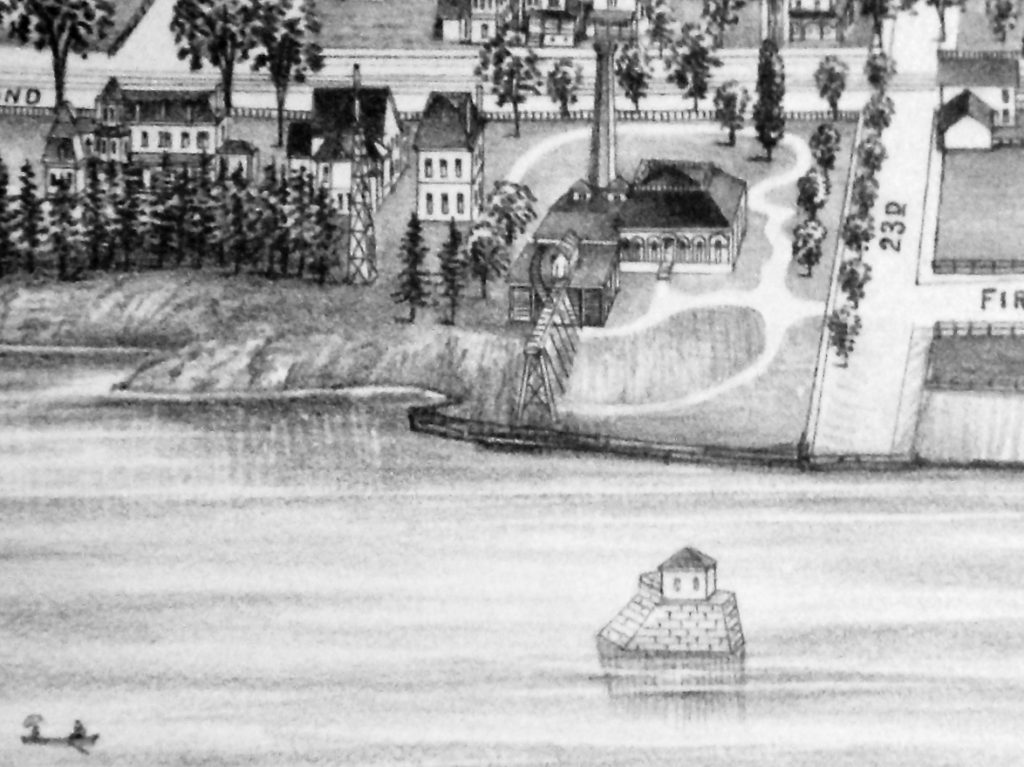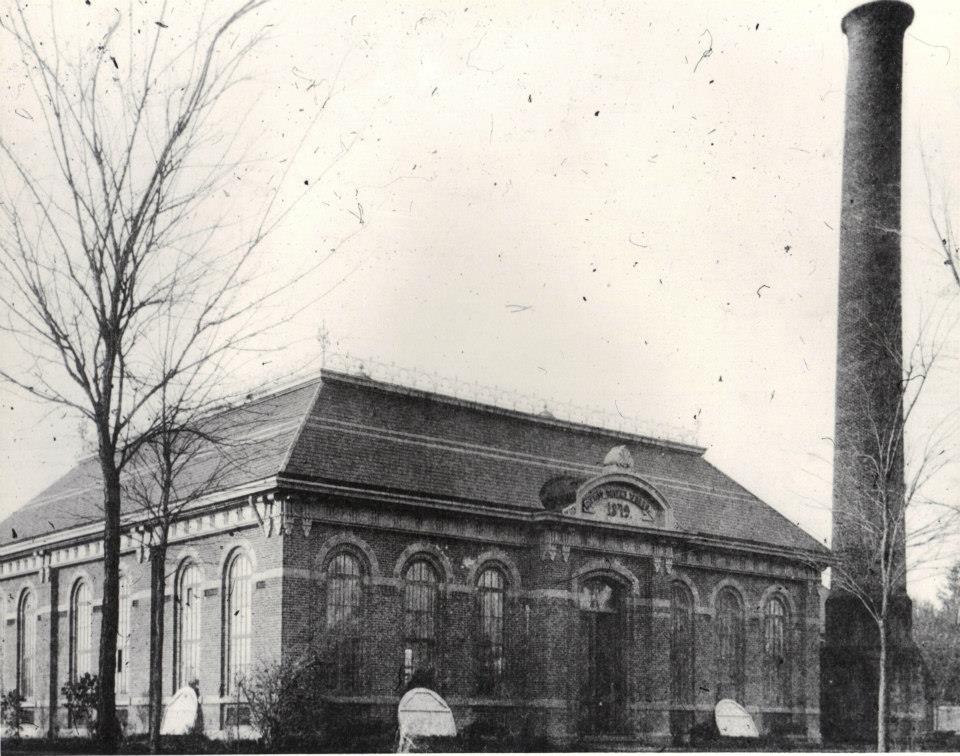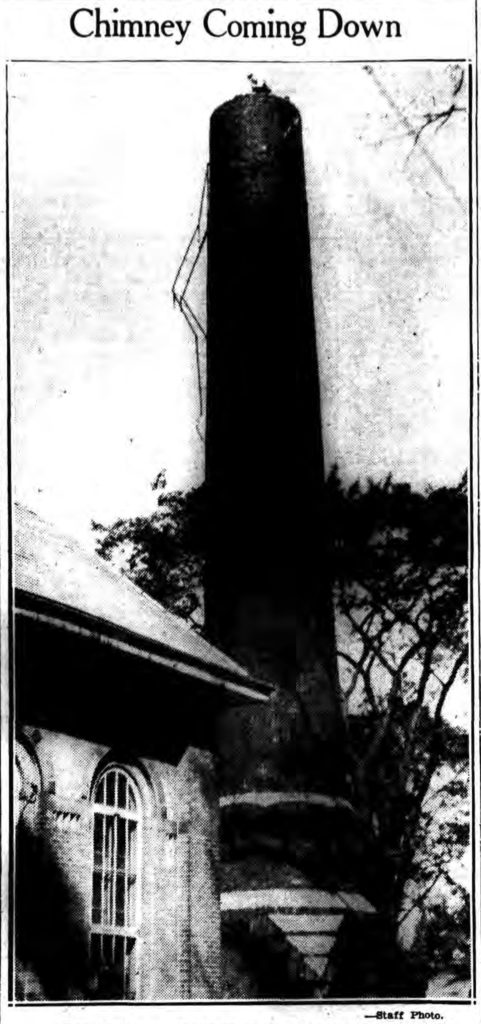Bath House
The Lansingburgh, or North End, Bath House, formerly the Water Works Pump Station.
“Bath” or “bathing” to some extent referred to both the activities of washing oneself and to swimming. See e.g. the OneLook Dictionary search for “bathing”: https://onelook.com/?w=bathing&ls=a
The Bath House was open from about 1910 until at least 1930 when a drowning due to the City of Troy’s failure to provide lifeguards or safety equipment seems to have factored into its largely disappearing from newspapers, evidently closing around that time. In 1930 Miami Beach was created and in 1932 the Troy Motorboat and Canoe Club made a beach at 121st Street on the Hudson River, though unlike the Bath House both were dependent on fair weather. There was some discussion of the City of Troy refurbishing the facility in the 1940s.
The Knickerbacker Pool (called the Lansingburgh Pool its first year) opened in 1955 in Knickerbacker Park, though it too was an outdoor swimming facility. Ultimately the bath house property was sold in 1961.
There had been some bathing or swimming locations in the Village of Lansingburgh prior to the Bath House at 123rd street; swimming in the Hudson River had been one popular option. However, the issue with those taking a dip in the Hudson River often was that people were doing so in the nude, and in sight of people thereby offended. Another location spoken of had been a bath house at John Bacon’s Union Garden, perhaps in the area of The Glen or the kill flowing from it, Gould’s Creek.

Detail of 123rd Street Park and Water Works Pump Station (later Bath House) from “Lansingburgh, N. Y., Third Ward, 18th Street North.” Troy, NY: L. R. Burleigh, 1891.
AN ACT to establish free public baths in cities, villages and towns
APPROVED by the Governor May 4, 1892. Passed, three-fifths being present.
The People of the State of New York, represented in Senate and Assembly, do enact as follows:
SECTION 1. It shall be lawful for any city, village or town to establish free public baths. Any city, village or town may loan its credit or make appropriations of its funds for the purpose of establishing free public baths.
§ 2. This act shall take effect immediately.
Laws of the State of New York Passed at the One Hundred and Fifteenth Session of the Legislature. Vol 1. Albany, NY: Banks & Brothers, 1892. 939.
The first successful indoor public bathhouse in the United States opened in New York City in 1891. The “People’s Baths” resulted from a coalition of private charities which included the New York Association for Improving the Condition of the Poor (AICP), the New York Mission Tract Society, the Protestant Episcopal City Mission, the Society for the Prevention of Cruelty to Children, the New York Academy of Medicine, the Charity Organization Society and the St. John’s Guild. […]
State Commissioner of Lunacy Goodwin Brown was so impressed with the sanitary results of replacing tubs with showers in all state asylums that he drafted a bill, which became law in 1892, authorizing local governments to use public money for municipal baths. When few towns took advantage of the provision, the state in 1895 enacted a new law, also drafted by Brown, compelling each municipality of over 50,000 people to establish a system of free public bathhouses. The law required each bathhouse to have hot and cold water and to be open not less than fourteen hours each day. Generally cities were slow to comply with the law—the first municipal bath-house in the state opened in Buffalo in 1897, and by 1904 only thirteen had been built statewide.
Glassberg, David. “The Design of Reform: The Public Bath Movement in America.” American Studies 20(2). Fall 1979. 9-10.
AN ACT to promote the public health and to amend chapter four hundred and seventy-three of the laws of eighteen hundred and ninety-two, entited “An act to establish free public baths in cities, villages and towns.”
The People of the State of New York, represented in Senate and Assembly, do enact as follows:
Section 1. Chapter four hundred and seventy-three of the laws of eighteen hundred and ninety-two, entitled “An act to establish free public baths in cities, villages and towns,” is hereby amended so as to read as follows:
§ 1. All cities of the first and second class shall establish and maintain such number of free public baths as the local board of health may determine to be necessary; each bath shall be kept open not less than fourteen hours for each day and both hot and cold water shall be provided. The erection and maintenance of river or ocean baths shall not be deemed a compliance with the requirements of this section. Any city, village or town having less than fifty thousand inhabitants may establish and maintain free public baths, and any city, village or town may loan its credit or may appropriate of its funds for the purpose of establishing such free public baths.
§ 2. This act shall take effect immediately.
Laws of the State of New York, Passed at the One Hundred and Eighteenth Session of the Legislature. Vol. 1. Albany, NY: James B. Lyon, 1895. 178.
—The law commands a public bath house for Troy. The city officials apparently think the law does not count, for no public bath has been provided. The excuse made is that the bath would cost too much. But Garrett J. Benson of Albany offers to bring his floating bath house to Troy for the season for $900. There is no apparent reason why the city should not expend the $900 and provide for the season an opportunity which is in the interest of health, pleasure and decency. Now the open river is shamelessly used as a public bath house, and the practice is defended on the plea that there is no other place for bathing.
“City Notes.” Troy Daily Times. July 25, 1896: 3 col 2.
[January 1, 1901, the law annexing the Village of Lansingburgh to the City of Troy took effect.]
Arrangements have been made for a public bath in Lansingburgh for six months. It is thought that the old pumping station will not be ready before July 1 for that purpose.
“Home Matters.” Troy Times. December 18, 1908: 3 col 1.

Lansingburgh Bath House.

Bath House at 2nd Avenue and 123rd Street from Sanborn Insurance Maps: Troy, NY, 1903, Vol. 1., Map 51. (Cropped from scan by RPI)
—The work of building the large tank in the North End bathing station is now under way. It is being built of reinforced concrete, without the usual tiling, and will have a litholite border around the top.
“Lansingburgh.” Troy Times. August 5, 1910: 6 col 1.
—The masonry work on the tank at the North End public bath house is finished and work on the cement floor was begun yesterday.
“Lansingburgh.” Troy Times. August 17, 1910: 6 col 2.
Without any ceremony other than the announcement by Caretaker Pratt that everything “was ready,” the punge bath in the new Lansingburgh bath-house was opened this morning. The first person to take a swim was Charles Lewis, residing at [One Hundred] Twenty-third Street. The pool is a good one. It is four and a half feet at its shallowest part, sloping down to a maximum depth of seven feet. The hours for bathing are:
Monday—10-11:3-, women and girls; 2-8 men and boys. Tuesday—10-11:30, boys, under fourteen. Wednesday—10-11:30, women and girls; 2-8, men and boys, Thursday, 10-11:30, women and girls; 2-8, men and boys. Friday—10-11:30, boys under fourteen; 2-8, women and girls. Saturday, 10-11:30, men and boys, 2-8, men and boys.
Troy Times. July 29, 1911: 5 col 2.
—
Public Bath Largely Patronized—Some of the Features—[…]
The Lansingburgh public bath was patronized by 155 men Saturday, many of them residents of the southernmost part of the city and one or two of them non-residents, who were forced to pay ten cents for the privilege of washing up under the showers and taking a plunge in the big swimming tank, which is kept at the right temperature at all hours of the day, no matter how cold the air is without. Superintendent J. G. Pratt told a Troy Times reporter that although the attendance had fallen off considerably since the cold weather began the attendance throughout the week was still large. At times during the evening when the number wishing a bath is many the sixteen shower baths are kept working all the time and the bathers are obliged to wait their turns as in a barber shop. The majority of those who patronize the bath are laboring men, who come directly from work, and during the evenings, when men are allowed the use of the bath, there is a rush for towels and soap, which are distributed to each applicant after he has signed the register. It is noticeable that many well-to-do people prefer a warm shower bath at the public bath-house to a session in the little blue bathtub at home, and the swimming tank is also a big attraction. The bath is open daily from 10 o’clock in the morning until 9:30 o’clock at night. The bathing schedule is as follows: Monday, 10 to 3 o’clock, men; 3 to 9:30 o’clock, women and girls; Tuesday, 10 to 9:30 o’clock, men and boys; Wednesday, 10 to 3 o’clock, women and girls; 3 to 10:30 o’clock, men; Thursday, 10 to 3 o’clock, men; 3 to 9:30 o’clock, women; Friday 10 to 3 o’clock, men and boys; 3 to 10:30 o’clock, women and girls; Saturday, all day, men only. Signs are posted about the building for the guidance of bathers. Among the suggestions is that persons remain out of the water just after having eaten heartily. Another is to the effect that while it does not harm to enter the water while perspiring from exercises, it is unwise to do so until the heart-action and respiration have become normal. Another note advises against standing about in wet clothes. “Take a brisk walk after the bath,” says another notice, “and you will feel much better than if you remain about the bathhouse and fail exercise.” Notices say that if safeguards are exercised there is absolutely nothing to be feared from cramps. For the benefit of those who make their ablutions at the Lansingburgh bathhouse, a board walk has been laid directly from the corner of [One Hundred] Twenty-third Street to the door of the building.
Troy Times. December 22, 1913: 9 col 3.
—
Free Baths for Those Who Wish Them […]
The Troy Times has received the following:
Troy, N. Y., Dec. 31, 1914.—Dear Sir: In the Lansingburgh notes of your paper December 30 I read of the men who visit the Fourth Precinct. I feel sorry that such men do not know that a bath-house exists in our town where they can have hot and cold water, soap and towel for free. Days are set apart for men and also for women. There is no reason why anyone should go without a bath. The city provides this and the taxpayers pay for it. The bathhouse is presided over by a male attendant on men’s bathing days and by a matron on bathing days for women.
A POOR MAN AND A PATRON OF THE NORTH END BATHS.
Troy Times. January 2, 1915: 2 col 5.
SUSPEND FOUR TROY WORKERS
Pending the outcome of an investigation into the alleged destruction of new boilers, pumps and other equipment at the Lansingburgh bath house, four municipal employees were suspended from the city payroll and Martin Carey, transferred from the public works garage to supervision of the public bath.
The bath will not be open today because of the suspension of the regular staff. Commissioner Alfred E. Roche has ordered new apparatus and parts be installed.
Damage of $5,000 was caused to the boilers and equipment, Commissioner Roche said.
Neglect and mismanagement on part of the employees is charged. In a letter to the employees at the bath house, Commissioner Roche said, in part:
“Charles of inefficiency, mismanagement and carelessness will be served unless restitution is made to the city for equipment damaged under your management and supervision.”
Commissioner Roche has suspended from the city payrolls John J. King, engineer at the bath house; Martin Connolly, night attendant; Daniel Mullaley, caretaker, and Mrs. Lillian O’Neil, matron.
Albany Times-Union. January 29, 1930: 10 col 2.
Troy Times. September 25, 1930: 13 col 7.

Ben Fraser, a member of the Department of Public Works, is shown atop the chimney of the Public Bath House on Second Avenue in Lansingburgh as he commenced its destruction. For a long time the chimney has been in a dangerous condition.
“Chimney Coming Down.” Times Record. October 8, 1938: 7 cols 3-4. (Staff Photo.) (Cropped from scan by fultonhistory.com)
—
Says Location Would Be “Most Suitable” For New Swimming Facilities.
The North End Bath, obsolete for several years, was today recommended by Mayor John J. Ahern as a new swimming pool for the Lansingburgh section of the city.
A committee of members of the All-American Social Club advocated a new swimming pool for this section of the city.
Mayor Ahern stated that he inspected the bath during the last few days and he thought it “would be most suitable for a pool.”
He stated that the bath needed new improvements such as retiling and repairs to the outside of the building.
William J. Martin, committee head, last night stated that the club members felt that the facilities offered the children of Lansingburgh can be expanded.
The group also recommended the resurfacing of the outdoor basketball court at the 112th Street playground.
Times Record. July 13, 1947: 5 col 6.
KEPT PROMISES OF LAST CAMPAIGN, MAYOR DECLARES
—
Ahern Lists Moves Made During Present Term of Office
[…]
Mayor Ahern said that with the formal launching of this year’s campaign for control of the municipal government that he intended to not only lay before the people what has been done to “overcome many of Troy’s major handicaps, but also to present plans embracing the next four years.”
Included in those plans will be the “redevelopment of a swimming pool in the North End Bath, a project on which Alderman Henry E. Smith has been most insistent,” the Mayor said.
Times Record. October 1, 1947: 7 cols 3-4.
The City of Troy today sold the old North End Bath to Dr. Rudolph L. Coletti, a Lansingburgh surgeon, for $15,000. Dr. Coletti’s office is located at 246 5th Ave.
Times Record. July 5, 1961: 13 cols 6-7.